↓ Download the Full Newsletter (PDF)
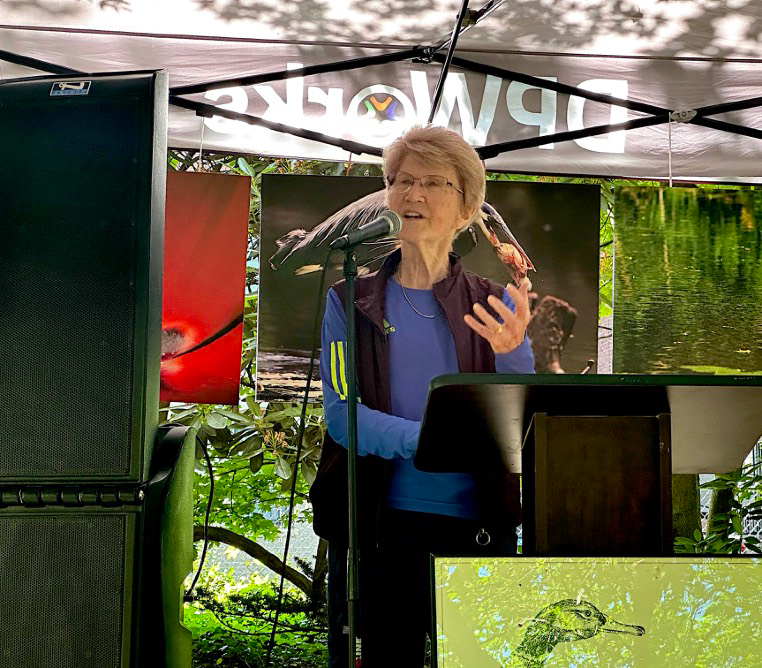
Reflections on the 50th anniversary of Hall’s Pond as a Nature Sanctuary
by Evelyn Murphy
In June 2025, the Friends of Hall’s Pond gathered to celebrate the 50th anniversary of Brookline’s designation of this pond as a Nature Sanctuary. For five decades, because it is situated in an urban community, this haven for wildlife and vegetation has enriched the lives of adults and children of many cultures. That, in itself, was cause for celebration.
Yet, at this particular moment in America, we should also be mindful of a timely lesson in Hall’s Pond’s evolution, that is, how Brookline acquired Hall’s Pond.
In January 1975, Brookline’s Mike Dukakis became Governor of Massachusetts. At his request, I left my position as a partner in a British architecture and planning firm, best known for its master plan of Milton Keynes, a new town west of London, in order to serve as his Secretary of Environmental Affairs.
One of my responsibilities as Secretary was the allocation of monies from the Federal Land and Water Conservation Fund. As an American partner in that British firm, I had been involved in open space planning in rebuilding cities like Detroit and New York City ravaged by civil rights riots and in other cities, in particular, Racine, WI, intent on avoiding massive civil unrest with proactive housing and open space development. So it’s easy to see that I brought into this state leadership role a profound regard for the value of urban open space to the lives of people, particularly urban dwellers who could not afford transportation to far off outdoor nature and recreation settings.
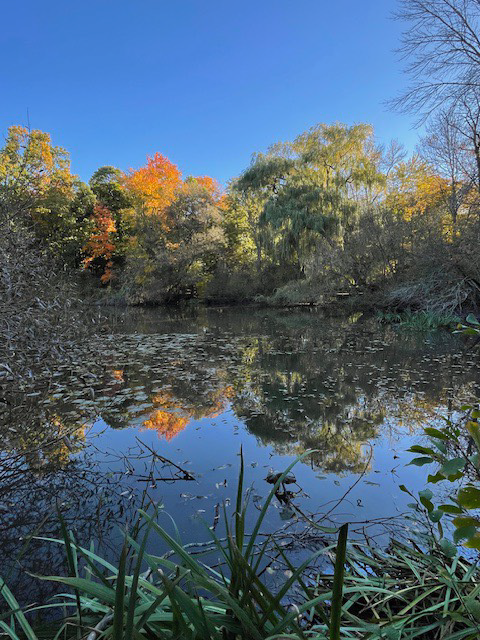
In a conversation with Fran Meaney whom I met in the process of being vetted for the Secretary’s position, I told him about my intent to channel federal Land and Water Conservation Funds (LWCF) allocated to Massachusetts into urban open spaces. He arranged for me to see Hall’s Pond and its urban environs. To this day, every time I walk through Hall’s Pond, I still find deep satisfaction in the fact that one of the first investments of these federal funds that my office directed was to Brookline for the acquisition of Hall’s Pond. Many investments of federal LWCF over the ensuing four years included now well known urban open spaces like Columbus Park in Boston and what is now Lowell National Park, and many more.
To me, the lesson of the LWCF for Hall’s Pond is simple: when federal, state, and local policies are aligned, public funding investments have long term value far beyond what anyone envisions at the outset. Harmony among levels of government best serves us all.
Hall’s Pond remains special. It is a sanctuary in its truest meaning—a place of refuge and protection—thanks to the dedicated efforts of the Friends of Hall’s Pond and the town of Brookline. Thank you for your dedication to preserving and enriching this gem of nature. You make this former Secretary of Environmental Affairs proud of what all of us together have contributed over the last half century.

From the Co-Presidents
by Ann Frechette and John Shreffler
The past year has been momentous for the Hall’s Pond Sanctuary with the celebration of the 50th anniversary of its designation as a nature sanctuary, the start of the boardwalk renovation, major invasives removal projects, a well-attended spring community day, and a delightful annual meeting featuring photographer Lane Turner and his book project documenting a year in the life of Hall’s Pond.
The 50th anniversary celebration on June 22 was the highlight of the year as it enabled us to gather the people who made the sanctuary possible, including former Lieutenant Governor Evelyn Murphy, past presidents Barbara Mackey, Ellen Forrester and Janice Provencher, Commissioner of Public Works Erin Chute, former town arborist and conservation administrator Tom Brady, current conservation administrator Alex Cassie, relatives of founder Jo Albrecht, town staff, past and present board members and volunteers. Speakers included State Representative Tommy Vitolo, Chair of the Conservation Commission Marcus Quigley, Select Board Member John VanScoyoc, Dr. Evelyn Murphy, Barbara Mackey, Ann Frechette, Judy Currier, and Erin Chute who read a lovely poem she wrote in tribute to Hall’s Pond.
Our Annual Meeting on June 12 was another highlight of the year as nearly seventy Hall’s Pond enthusiasts gathered in Hunneman Hall at the Brookline Public Library to hear Boston Globe photographer Lane Turner present photographs from his year-long documentation of the flora and fauna of the sanctuary. Grouped seasonally, his stunning images revealed never-before-seen aspects of pond life including surprising insect behavior, the intricacies of plant life, and even frozen tree sap. Published now as a book entitled A Hall’s Pond Year, it is available at blurb.com.
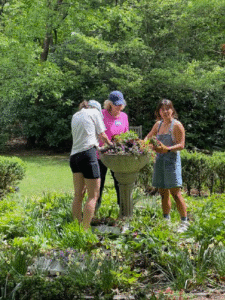
Spring Community Day. (John Shreffler)
Our Spring Community Day was very well attended as we planted new native plants throughout the sanctuary to replace those lost to drought and to protect against the return of invasives along the banks of the pond. Our special thanks goes out to Board Member Kimberly Santo who has been instrumental in recruiting Boston University students to join us at Community Days. We appreciate the youthful energy! The Fall Community Day was limited to Hall’s Pond Maintenance Team members due to the recent closure of the sanctuary and was focused on rebuilding the path through the upland woods to cover up exposed tree roots and other tripping hazards.
The work to remove invasive plants from the sanctuary is ongoing. The tarping project we started in November 2024 to control lesser celandine has continued and appears to be working. We will plant native competitor plants in Spring 2026. The purple loosestrife DPW staff removed at Spring Community Day 2025 returned in only a limited manner throughout the growing season, as the buttonbush and purple iris we planted, along with a surprise plethora of goldenrod, took over its place. An additional project to remove invasive yellow iris from along the banks of the pond was recently funded through a Community Preservation Act grant and will be implemented by DPW. Newly emerged tree-of-heaven seedlings were removed at our regular maintenance sessions.
The sanctuary will remain officially closed to the public throughout the winter and we ask that would-be visitors not jump the fence or otherwise violate the closure. The sanctuary is now an active construction site and is off-limits. We look forward to welcoming everyone back when the boardwalk reconstruction is completed.
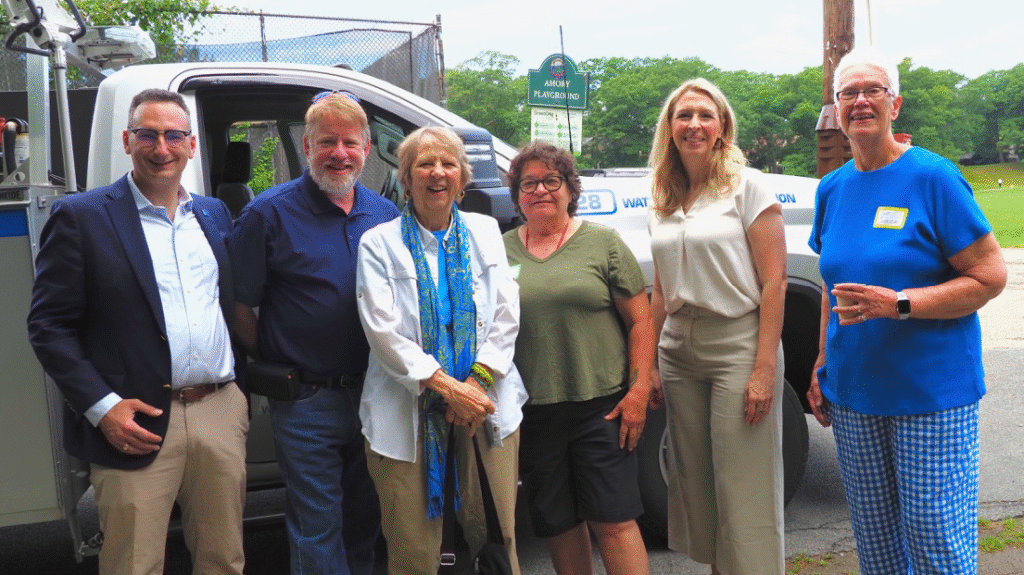
(Fran Perler)

Hall’s Pond: Fifty Years of Still Water and Strong Will
For the Friends of Hall’s Pond – 50th Anniversary of the Hall’s Pond Sanctuary by Erin Chute, Brookline Commissioner of Public Works
Not big, not loud—just humble and still, Tucked near the courts, at the base of the hill, Where willows lean low and the breezes are kind, A soft green escape from the world left behind.
Yet long before then—before streets had a name, When the land breathed quiet and no fences came— It started, of course, as a cedar swamp land, With peat underfoot and no human hand. Where herons would visit, and frogs used to hum— And silence was part of the pond’s native drum.
Then time marched along, as it always will do, And city life crept where the wild once grew. But Minna Hall saw it through different eyes— She watched birds in flight cross the gray Boston skies. She rallied with women in hats stitched with care, To save the wild birds from hatpins and flair.
They launched a movement…fearless…refined, To save birds from fashion and humankind. She dreamed of a future where birds would still sing, And left us this refuge, this wild offering.
As cities grew denser, and roadways were laid, Stormwater rushed where the cattails once swayed. The pond slowly shrank, and the edges grew bare— It needed a champion. It needed repair.
In the 1970s, some neighbors took note, And raised their concerns, their shovels, and vote. The Town bought the land—yes, with passionate clout— And the Friends of Hall’s Pond soon started to sprout.
They weren’t seeking glory, just balance and peace, A space for the bird song; where the traffic might cease. They raked, and they rallied, with no time to rest, Fueled by one quiet truth: this pond is our best.
But then came the skeptics—the doubters, the flak— Who claimed, “It’s a swamp! We don’t want it back!” But restoring a pond takes political flair, And meetings, and memos, and fighting for air.
So back to the drawing board—with stakes raised anew, A plan to restore Hall’s Pond began to take view. The drainage improved, the storm flows subdued, And the pond breathed again—revived and renewed.
They united the woods and the pond as one whole, So walkers and birds could both reach their goal. A sanctuary stitched from old roots and new beams, Connected by vision, sweat equity, dreams.
The boardwalk was anchored with helical piers, A feat that took vision—and quite a few years. And by 2002, the great work was done— A wild was reclaimed, and a new age begun.
From Barbara to Betsy, from Lee to the rest, They gave it their all, and gave it their best. They honored Miss Albrecht with granite and wings, A stone angel now watches over seasons and springs.
And fifty years on, what a legacy made: I’ve seen children laugh in the willow’s green shade. I’ve seen lovers strolling and elders at rest, And one nervous young man, on bended knee, in a tie and a vest.
I’ve seen people gather in joy, others mourn in sorrow, Grieving a loved one, unsure of tomorrow. I’ve watched someone practice an aria low, Letting their voice match the breeze as it blows.
Some sit and reflect, wh
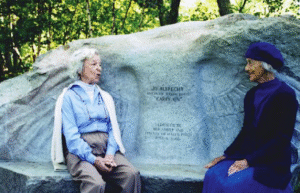
ile the woodpeckers tap, And the sounds of the city fall gently to nap. This place is a balm, a quiet embrace— A jewel of reflection, a soulful green space.
It’s more than a wetland—it’s memory and place, It’s healing and heritage, community grace. A place to reflect, to restore, to belong— A space where the birds can still sing a song.
And the Friends? Oh, the Friends—you magnificent crew, With the grit of New England and hearts that are true. You’re the reason this place is still whole. You rake, and you weed, and you reach for the soul.
You educate neighbors and fundraise with grace, You care for this pond like a cherished green space. You’ve welcomed young students and watched nesting birds— You’ve tended with action far louder than words.
So instead of a toast, I offer this rhyme, To honor your labor, your hearts, and your time. Let’s lift up this space with each step that we take— It’s sacred because of the difference you make.
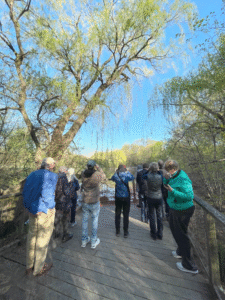
Predictable and Unpredictable
by Neil Gore
In the birding world, and in the world in general, we have a mix of predictable and unpredictable events. We each have our own comfort zone for the balance of these two experiences. One aphorism of mindfulness practice can be to “Expect the Unexpected.”
My bird of the year at Hall’s Pond was not something rare or unusual. The Eastern Phoebe is both familiar and predictable in its own way. Among the perching songbirds (“passerines”) it is arguably the earliest insect-eating migrant to be found each year at Hall’s Pond. It is a nondescript brownish-gray, with a grayish/white breast. It has relatively subdued field marks. It would be easy to overlook. Except for a couple of things.
It is a flycatcher, so it cannot survive unless there are flying insects. The first hatching of these insects marks the arrival of very early spring. Swallows also feed like Phoebes, but apparently they need a larger area to forage, and thus, while common elsewhere in our area, they are infrequent at Hall’s Pond. Perhaps the smaller area of Hall’s Pond provides sufficient insect hatching for Phoebes. Being here in early spring also means that vegetation has hardly leafed out at all. So in theory, it is ideal bird spotting season. Yet Phoebes are quite inconspicuous.
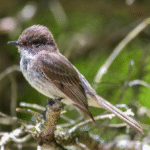
Except for one thing: their feeding habit. A Phoebe will fly out from its perch in a graceful short loop, as if catching a single insect. It will return to a second nearby perch. It will then repeat its smooth flight, landing on perch #3. When next it flies in the same manner, presumably catching its insect, it will then fly somewhere different but nearby; and then the pattern resumes. It gives the impression that it has caught the only 3 flying insects in that sector, and has now moved on to the next “room.” This flight pattern is predictable, distinctive, and unmistakable for identifying it as an Eastern Phoebe.
When I go to Hall’s Pond in early spring, sooner or later, today or tomorrow, I will see a Phoebe. On any particular day, it is unpredictable. It is unusual to see more than one at a time each day. Last spring someone reported seeing 6 in one day, which I found rare and amazing.
Robins used to be the first sign of spring, but now they are seemingly year-round residents. For me, the Eastern Phoebe has become the new First Sign of Spring, bringing an uplifting spirit.
Sighted at Hall’s Pond Sanctuary in 2025, among many many other species!
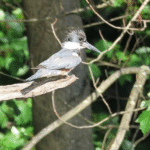
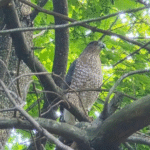
(Priscilla Smith)
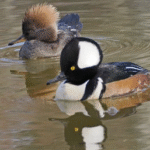
(Peter Lowy)
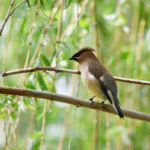
(Rob Meyer)
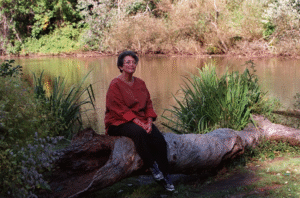
Photo by Pat Greenhouse, Boston Globe, from Emerald Necklace Conservancy via GreenSpace Alliance.
Betsy Shure Gross: a Tribute
by Barbara Mackey
Just a month before Betsy Shure Gross died in July, the Town of Brookline and the Friends of Hall’s Pond celebrated a remarkable anniversary which, I imagine, had Betsy raising a toast from her home in California, saying ‘well done.’
After Jo Albrecht died in 1994, the Friends of Hall’s Pond might have faded away. Jo had launched the Friends in 1976 and managed it for 18 years, not quite single-handedly, but almost. Betsy would never let the Friends fade.
She was there at the beginning, when town, state, and environmental leaders pulled together and established the first nature sanctuary to be purchased by the people of Brookline. Employing energy, smart strategy, powerful skills of persuasion, and an enormous rolodex, Betsy kept her eye on the Friends of Hall’s Pond for all these years. Sometimes front and center, other times guiding from a distance.
State Representative Tommy Vitolo spoke to the essence of Betsy’s commitments at the June celebration. “This was her park because every park was her park, and not in a selfish way, but in a civic-duty way and an understanding that we don’t get to have places like this by accident. We only get to have places like this if we fight for them, if we pay for them, and if we show up every week or every year at clean up and do our part.”
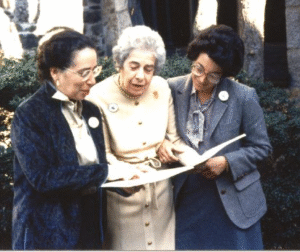
Betsy guided the Friends’ transitions at several key periods, and notably during my decade with the Friends from the early 90s. She pushed for a master plan followed by the huge environmental restoration of 1999.
Throughout, she spurred major fundraising for private-side contributions to the sanctuary’s maintenance and the environmental education it featured.
Her dogged commitment to the stewardship of Hall’s Pond continued from long distance for the past ten years as she remained a Friends board member with guidance delivered remotely. She alerted me back in the spring, during our common-birthday phone call, that the big 50th Anniversary celebration was in the works. She would have loved to be there. We felt her absence.
Betsy frequently used Jo Albrecht’s favorite expression, and I believe it would have been her charge to the Friends of Hall’s Pond — “Carry On.”
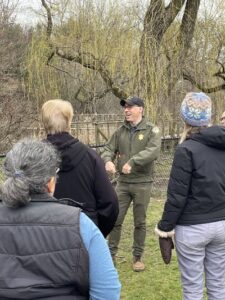
(John Shreffler)
From the Conservation Administrator
by Alex Cassie
It’s hard to not think about change with the coming of the fall, with shifts in daylight, temps, and New England landscape colors. And that is ever so apparent in the coming changes to Hall’s Pond. With construction currently underway, the Department of Public Works (DPW) teams in Parks & Open Space and Sustainability & Natural Resources are thrilled about upcoming improvements at Hall’s Pond Sanctuary and Amory Woods. These renovated boardwalk systems will ensure that future generations can enjoy these natural urban oases, and promote not only the continued exploration and enjoyment of these spaces, but also the protection of wildlife habitat and wetland resources.
The DPW is fortunate to have such a dedicated volunteer stewardship team as the Friends of Hall’s Pond. Even with disruptions to access, the team has continued their biweekly service projects to promote native species within the sanctuary and improve the space for park visitors (and wildlife).
While the Sanctuary will remain closed for a time to accommodate the construction of these new boardwalks, we welcome visitors to check out Brookline’s other sanctuaries and passive, wooded spaces such as D Blakely Hoar Sanctuary, Lost Pond Sanctuary, and Dane Park and explore the wealth of wild space the Town boasts within an urban environment. We look forward to a fall and winter of enjoying these tranquil environments and observing the changing of the seasons under a forest canopy, and hope you’ll do the same. See you in the spring!
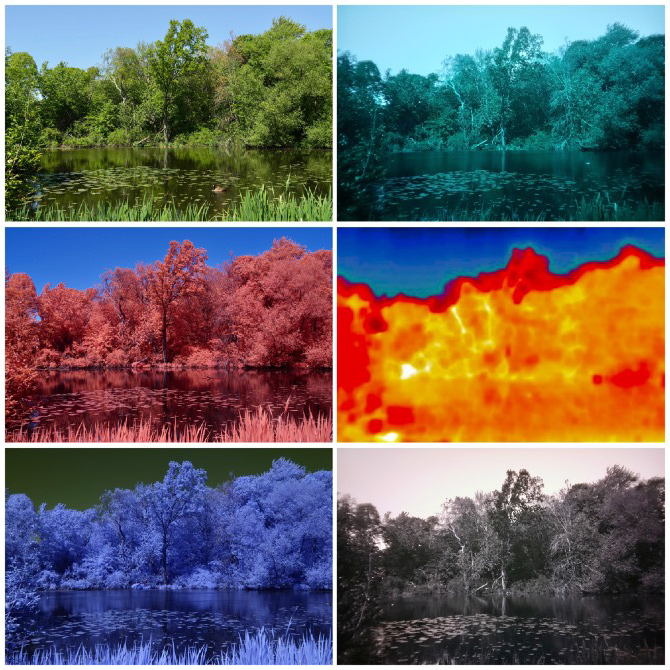 Is it Art, Science … or Both?
Is it Art, Science … or Both?
by David Chalpin
SIX SPECTRAL VIEWS, each a separately acquired photograph, of Hall’s Pond:
Taken from a different vantage point than those in the two previous newsletters, this multispectral photo montage consists of the following: Upper left is Visible light only (wavelength range 400-700 nm); upper right is color Ultraviolet (wavelength range 320-520 nm); middle left is a color IR (Infrared) rendering near-IR light as red (wavelength range for this proprietary filter is approximately 410-1200 nm); middle right is Thermal (far-IR wavelength range 8-14 μm); lower left is a color IR rendering near-IR light as blue (wavelength range 550-1200 nm); and lower right is Ultraviolet only (wavelength range 320-400 nm.)
